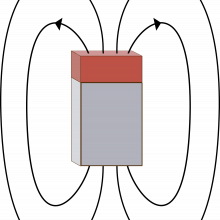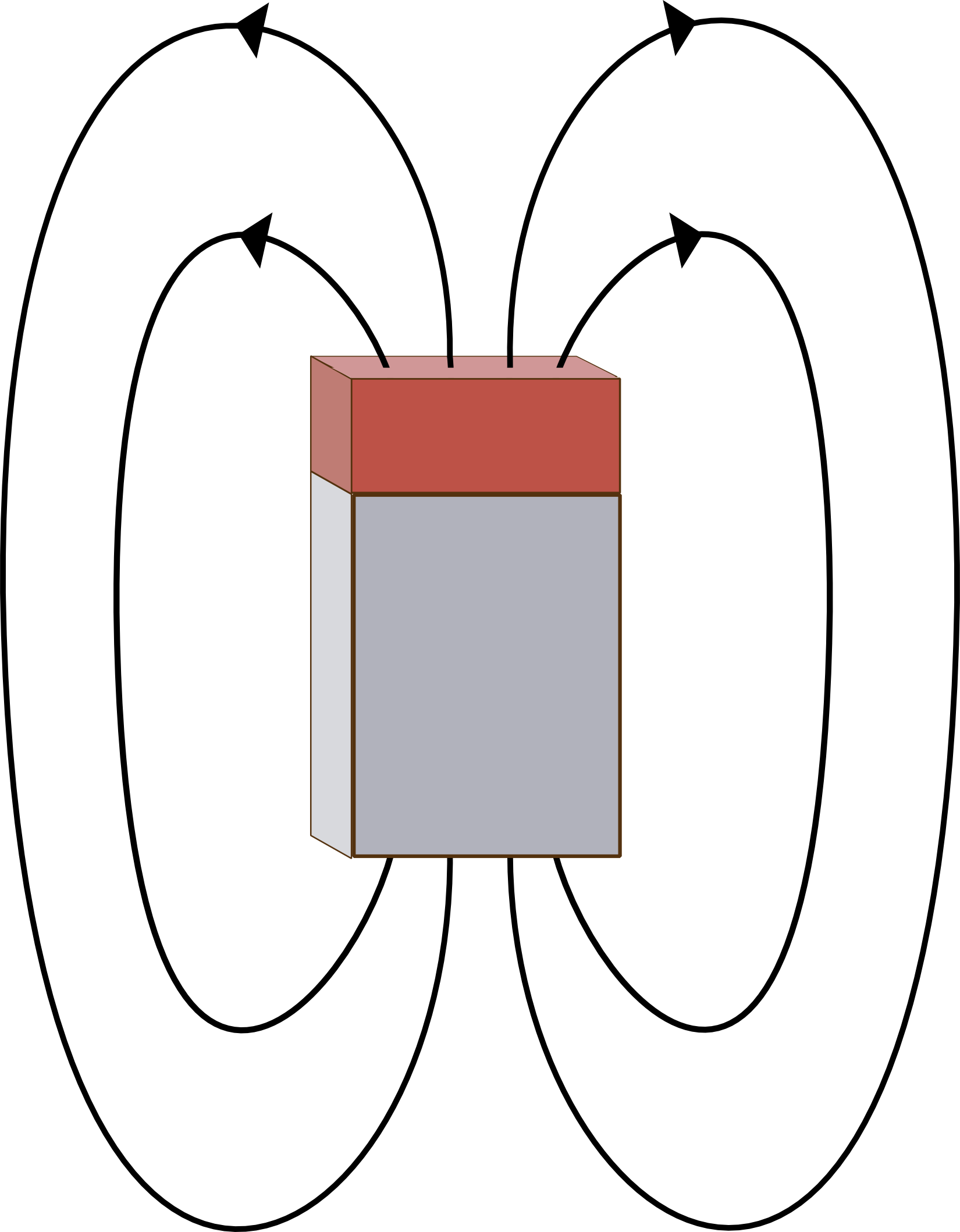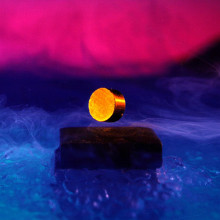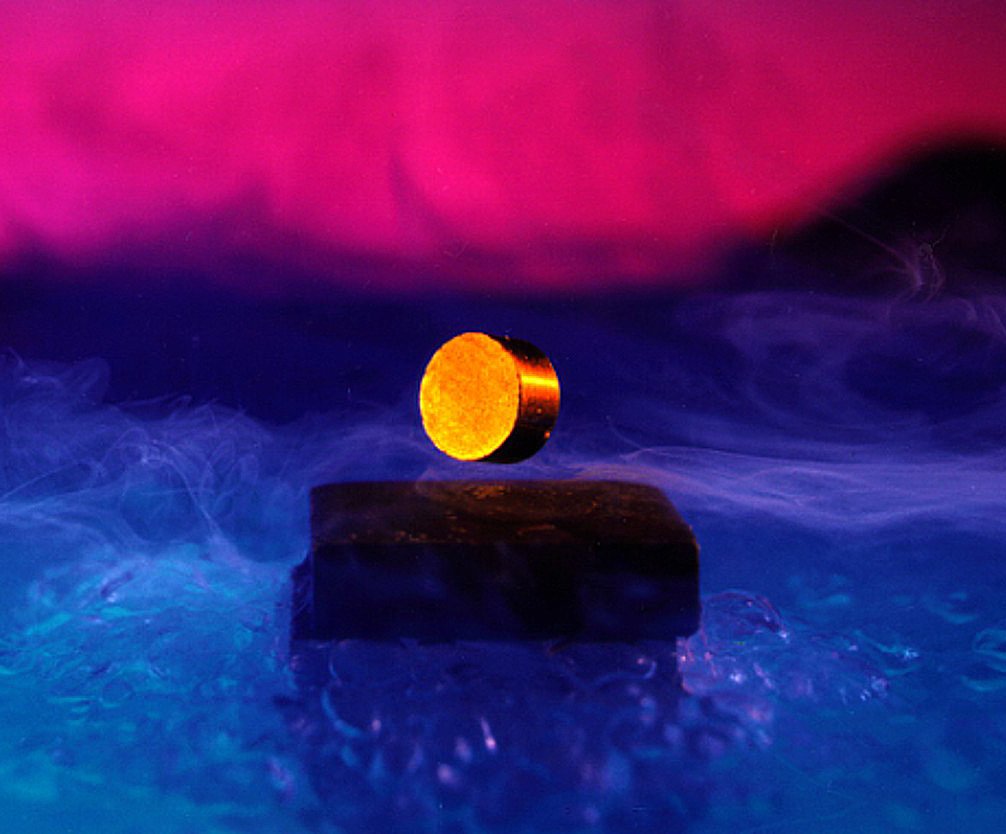This month we attract your attention to the power of magnetism as we explore just what magnetism is and how it can be induced. We also explore the role of magnetism in superconductors, as well as a class of materials known as multiferroics! Plus, we bring you the latest news and events from the light source.
In this episode

01:34 - The Materials and Magnetism Beamline
The Materials and Magnetism Beamline
with Steve Collins, Diamond Light Source
Meera - Magnetism is a word we've all heard of. Many of us may think of the horseshoe magnets that cause metals such as iron to fly towards them or else the bar magnets we may have come across in science lessons at school. The forces we see here are down to the presence of magnetic fields which can be permanently found in certain materials, or else induced in others causing the attraction or repulsion we then see. A good insight into the workings of magnets and magnetic fields can benefit a wide range of technologies we rely on heavily today, such as data storage. Steve Collins is the Principal Beamline Scientist on Diamond's Materials and Magnetism Beamline and he gave me an introduction to the properties and features of magnetic materials.
the bar magnets we may have come across in science lessons at school. The forces we see here are down to the presence of magnetic fields which can be permanently found in certain materials, or else induced in others causing the attraction or repulsion we then see. A good insight into the workings of magnets and magnetic fields can benefit a wide range of technologies we rely on heavily today, such as data storage. Steve Collins is the Principal Beamline Scientist on Diamond's Materials and Magnetism Beamline and he gave me an introduction to the properties and features of magnetic materials.
Steve - The most obvious and well known form of magnetism is what we call ferromagnetism, where basically magnetic materials would stick together and if you look on an atomic scale at what causes that, it's exactly the same thing but on a much smaller length scale. So you have tiny magnetic atoms which are interacting with each other, pointing in the same direction. But in fact a lot of magnetic materials are pointing in other directions and they tend to point towards each other or to find some other sort of exotic pattern arrangement so on average there's no net magnetic forces. And so you would say the materials, at least from a ferromagnetic point of view, are non-magnetic, but on an atomic scale are very much magnetic and have very interesting magnetic properties
Meera - So that essentially comes down to charges at the atomic scale on individual atoms?
Steve - It does exactly, but the important thing is not the static quality of the charges, but the fact that they are moving and classically you almost think of a planetary orbit of electrons around a nucleus, like a star, and they go round in a certain direction. You can imagine that each atom has a south pole and a north pole and to understand the structure and the symmetries and the electron properties at an atomic scale is absolutely crucial to understanding how the materials work.
Meera - What about the applications of this knowledge and this understanding of magnetism, what role does it play in everyday society, such as date storage?
Steve - Well, data storage is clearly the big growth area at the moment and of course using powerful magnets for making electric motors, but increasingly these very exotic magnetic structuresare expected to find use in electronic devices.
Meera - Steve, you're principal beamline scientist here at the Materials and Magnetism beamline, what type of research is taking place at this beamline?
Steve - At this particular beamline we look at the magnetic properties and related properties of materials really on atomic length scales, so combine the fairly conventional methods of X-ray diffraction which are used to understand the crystal structure of all sorts of materials in the physical and life sciences, to looking at relatively simple structures but we look in much more detail and understand from these measurements exactly where the magnetism is on atomic scales. We can see where the magnetism is, we can see which atoms are magnetic and we can even work out the cause of the magnetism in terms of whether it originates predominantly from the intrinsic magnetism of every electron which in the material, or because of the motion of the electrons around the atom.
Meera - Well we've come alongside your beamline now and there is a fine metal tube where the x-rays obviously come out, an area for the sample to actually be placed just in front of that tube, and then something that's kind of moving around it which I can imagine picks up the scatters from the crystals.
Steve - It does, we actually call this diffractometer which is effectively a large robot. The robot has 2 hands; one hand of the robot holds the sample that we are studying and moves it into the position we need, and the other hand of the robot will hold the equipment which detects the x-rays scattered from the sample and we have to synchronise the movements of both of the hands of this robot in order to carry out the measurements.
Meera - Looking at where the sample is actually mounted, there's a metal cylinder and it looks like a fairly complicated piece of engineering just for where the sample's placed?
Steve - That's right, this is because a lot of the materials that we are interested in have properties that change with temperature and the particular device that you are looking at can take us down to about 4 degrees above absolute zero in temperature.
Meera - So very cold?
Steve - Very cold!
Meera - Is there an example of a sample that could be looked at and then what kind of diffraction it would cause when an X-ray hits it?
Steve - A lot of the materials that we look at are materials that we call anti-ferromagnets and in these materials the atomic scale magnets tend to point towards each other, but the important thing from the diffraction point of view is that they form extra periodicities in the sample. So it's very much like a diffraction grating, like the diffraction of light that you would see from a CD or something like that, but because the magnetism forms an extra periodicity, it gives scattering at angles which would not see any scattering if the magnetism wasn't there. So the nice thing is, we have a very, very clean signal showing us exactly the effect that we are interested in. We can pick out either the magnetism, or some related process and home in specifically on that.
Meera - So what kind of application could this knowledge have?
Steve - Largely, well almost entirely in fact, in basic science and it's a question of understanding the properties of the materials. So where all the magnetic moments are in a crystal, which directions they point and also at the same time we often study any very small displacements. I mean these are displacements of a very tiny fraction of the size of an atom, but the displacements can have a crucial effect on the properties of the material and we can see those using exactly the same types of equipment.
Meera - Steve Collins, Principal beamline scientist on I16 or the materials and magnetism beamline.

08:20 - Multiferroics
Multiferroics
with Paolo Radaelli, University of Oxford
Meera - Paolo Rudelli is a Professor of experimental philosophy at the University of Oxford and he uses the beamline to study a class of materials known as multiferroics. These are materials that respond to both magnetic and electric fields, a response which results in a change in their properties and an understanding of this change could enable better control of magnetic media in the future. Paolo explains more about these materials.
Paolo - Essentially multiferroics are materials that can be addressed using two different fields. Current materials can be read or written but just based on their magnetic properties. We already know by Einstein's theory of relativity stipulated that really magnetism and electricity are two manifestations of the same phenomenon, they can be interchanged with each other if you have an object that goes to speeds comparable to the speed of light and this is precisely the phenomenon that we are exploiting to create materials that can be read and written electrically, which a much more energy efficient and faster way to address materials, but they can still hold the information magnetically which is very, very efficient as well.
Meera - What are the benefits of this then?
Paolo - We can make electronic devices, in particular electronic storage as well as information processing devices that are smaller, that consume less energy, well all know how annoying it is to have a laptop that runs out of battery or an  i-pod that runs out of battery.
i-pod that runs out of battery.
Meera - Multiferroic materials are materials where magnetism or electronic fields can be applied in order to change the magnetic properties.
Paolo - Exactly, so the idea here is that you can apply an electric field rather than a magnetic field and you can change the information state of a bit.
Meera - Could you give some examples of multiferroics compounds or materials?
Paolo - So multiferroics will tend to be oxides, simple oxides, things like chromium oxide. Iron oxide, or common rust, or rather the black form of iron oxide called magnetite is also believed to have multiferroic properties - simple binary oxide with a single metal bound to oxygen - all the way up to more complicated structures, structures that we call for example hexaferride that has 4 or 5 different metals. They're still rather common placed materials, you can find them in fridge magnets if you want.
Meera - So all of these materials you've mentioned, they vary with complexity, but they could all potentially have uses in things like data storage?
Paolo - They can all have uses. If you can first of all understand how they work, and this is part of what we are trying to do at Diamond, and also integrate with current electronic devices, this is the big challenge particularly for applied research because you have to essentially put these different types of materials on a chip that normally only has silicon and silicon oxides and this is the big technological challenge.
Meera - and so as you mentioned you're looking into some of the fundamentals of it to understand it a bit more, and a key issue seems to be the temperature that these multiferroics have to run at in order to induce this changes in the properties
Paolo - It is very much an issue, but we know that we already have materials that run at room temperature or even at higher temperatures. Things like chromium oxide for example would have the properties at room temperature but sometimes we also study materials in which these properties are displayed at very low temperatures. These materials are the first ones in which a new type of phenomenon, or underlying principle of multiferroicity is manifest and they are the first models that we have to try to understand this phenomenon. This is why we focus sometimes on materials that only work for the moment at low temperatures. If we can crack the secret, in a sense, then we can ask our chemist colleagues to find the right combinations of elements so that then these materials will be able to work at room temperature.
Meera - At Diamond you're using techniques such as X-ray scattering to look at the particular structures or arrangements. What have you been able to find out, what's been a recent discovery?
Paolo - What we can do, for example, is directly see the changes in magnetic structure as we apply an electric field. The arrangement of the magnetic moments in the crystal sets up a tiny electric field and this respond to the external electric field and as you move the internal field, the internal polarisation of the crystal by an external force, then the spins follow. So you switch the spin system by applying an electric field and this is the ultimate goal of what we are trying to do. If we could do that at room temperature in a material that is cheap and can be integrated into electronics then we will have reached the goal of our research.
Meera - Understanding how these particular materials work and function and can change their properties like that, what's it then hoped they can be used for?
Paolo - So we're hoping to use these materials to store information in a magnetic form and then to change the state of information say from zero to one in a bit, but rather than doing it by applying a magnetic field which is cumbersome and cannot be really scaled down to very, very tiny dimensions, we could apply an electric field which is much more localised, it has very low energy consumption when we put it into a device and you can have a much more compact, faster and overall better system.
Meera - Paolo Radaelli from the University of Oxford.

14:03 - News Update - Elastin and Earthworms
News Update - Elastin and Earthworms
with Sarah Boundy, Diamond Light Source
Meera - This is the April edition of the Diamond Light Source Podcast with me, Meera Senthilingam and this month we're attracting your attention with magnetic forces as we explore the atomic nature of magnetism. But, before we continue luring you down to the atomic scale, let's join Sarah Boundy from Diamond's Communications Team to find out what's been happening at the facility over the past couple of months, starting with a particularly notable visitor.
Sarah - Yes, in the middle of March we had a visit from David Willets who is the Minister for Universities and Science. He toured the synchrotron and met Diamond scientists and representatives from some of our industrial partners; that included GlaxoSmithKline, Rolls Royce, Evotech and Infinium UK and whilst he was here he officially inaugurated Phase 3, so that's our next 10 beamlines which he said he was delighted to confirm the funding for and he also said that Diamond is one of the really great scientific research facilities, not only in Britain, but around the world.
Meera - Well it's good that he met some of the scientists that are based here at Diamond because you've had some interesting papers published recently as well?
Sarah - Yes our publications database is going strong. We've now got over 1,250 published papers there. A recent highlight is work carried out on I22, that's our non-crystalline diffraction beamline, and the work was published in the American Journal PNAS - the Proceedings of the National Academy of Sciences. Researchers from the Universities of Manchester, Texas, Cardiff and Sydney used Diamond as well as the European Synchrotron Radiation Facility (ESRF) in Grenoble, France and the Advanced Photon Source in Chicago and they were using the X-ray facilities to determine the structure of Tropoelastin, that's the main component of Elastin, which is what allows tissues in humans and other animals to stretch. For example, when the lungs expand and contract for respiration, or when arteries widen and narrow over the course of a billion heartbeats, it's elastin that helps them to do this.
Meera - and what did they find out about its structure?
Sarah - They discovered that tropoelastin is a curved, spring like material which can extend to 8 times its initial length and return to its original shape with no loss of energy.
Meera - I guess this could have applications in synthetic polymers to make elastics?
Sarah - Well yes, elastics are used in applications as diverse as clothing, vehicles, tissue engineering and even space travel, so understanding how the structure of tropoelastin creates its exceptional elastic properties could enable the development of synthetic elastin-like polymers with potentially wide ranging potentials and benefits.
Meera - As well as this research, there's been more developments in a topic 
 that we've covered in the past about metal-munching earthworms?
that we've covered in the past about metal-munching earthworms?
Sarah - Yes, previously on the podcast we've heard from Mark Hodson from the University of Reading who's looking at the potential of earthworms as eco warriors, cleaning up toxins from contaminated soil. So he and his colleagues have published their latest findings using I18 which is our microfocus spectroscopy beamline. They were looking at tiny granules which were not quite 1 mm long and they were granules of calcium carbonate which is actually the main component of snail shell. These granules are excreted by earthworms that have been living in lead-contaminated soil. The group found that the excreted granules contained a substantial amount of lead meaning that the earthworms are able to ingest the lead which is then excreted out as a insoluble metal carbonates, potentially immobilising the metal and making it less available to plants.
Meera - So giving them a use in lead contaminated sites then?
Sarah - The granules did pick up a lot of lead, but the problem is that the granules are so small, they pick up less than 1% of the lead from the soil. So although the earthworms can survive in these toxic environments, the granules won't have a big impact on lead.
Meera - So what's next then, what could those be used for?
Sarah - The next step is to leek at different elements within the granules such as strontium and zinc. They might be concentrated more heavily and have more of an effect.
Meera - As well as the papers being published by scientists working here, they do need access to beamlines. What new beamlines have been developed?
Sarah - So we've had first light on I20, that's our X-ray spectroscopy beamline, also known as LOLA. It's going to be our 3rd spectroscopy beamline and our twentieth operational beamline when it comes online later this year. I20 will be used for chemistry, biology, environmental sciences and material sciences.
Meera - So spanning a wide range of disciplines. And lastly what about outreach, that's something you're always doing here at Diamond.
Sarah - At the end of February we took part in the Oxfordshire Science festival and we've just got back from the Big Bang Fair in London. We had some great hands-on activities that helped to explain how out magnets work in the machine and what kind of research Diamond is used for.
Meera - And what about regular members of the public wanting to visit Diamond. When's the next Inside Diamond day?
Sarah - The next Inside Diamond day is coming up really soon, but as usual it is already fully booked. The next available date is in June and people can find out more on our website.
Meera - Sarah Boundy from Diamond's Communications team.

19:05 - Magnetic Anapoles
Magnetic Anapoles
with Stephen Lovesey, Diamond Light Source
Stephen - When you ask yourself what is the property of a material which generate magnetism it is the fact that you have broken the symmetry with respect to the arrow of time. There is another symmetry, and that is the symmetry with respect to the direction of space. You can see this for example when you look at your hand in a mirror, your hand has changed from being left handed to being right handed and this is a direct observation of the fact that you have changed the direction of space. When you combine both the breaking of the direction time with breaking of the direction of space you generate a very special type of magnetism which is called the anapole, they are also called orbital currents. The anapole is thought to be most important in understanding a complex set of materials which are also able to conduct electricity without any resistance, called super conductors.
Meera - Just to step back a little bit there, so there are different types of magnets. So there are the dipoles that people know with the North/South divide and then there are these anapoles.
Stephen - That's quite correct. The dipole moment, for example, your compass needle, has the property that it does break the direction of time, the arrow of time in a material, it is also characterised by the fact that if you change the direction of space it remains unchanged. The characteristic feature of the anapole is that they have the property that they also change their behaviour if you change the direction of space. Now these anapoles can only be observed with light, so if you take a material and illuminate it with light, or X-rays, it gives you a method of imaging these anapoles.
Meera - Now you've been looking for the presence of these anapoles in high temperature superconductors. These are materials that once they reach a certain temperature, they lose their resistance and are able to have electrical currents permanently flowing through them.
Stephen - Yes, as you lower the temperature of a superconducting material, and some of the materials are extremely simple, elemental, then they lose their  resistance to passage of an electrical current. Unfortunately, the temperature that this desirable property comes about is very low, so in the practical application, say the transmission of electricity over power lines, so it's not a practical solution to an efficient transmission because you would have to have your cable at an extremely low temperature. The interest in this class of materials which are called high pressure superconductors is that the temperature at which they have this desirable characteristic is much higher, it's almost at room temperature.
resistance to passage of an electrical current. Unfortunately, the temperature that this desirable property comes about is very low, so in the practical application, say the transmission of electricity over power lines, so it's not a practical solution to an efficient transmission because you would have to have your cable at an extremely low temperature. The interest in this class of materials which are called high pressure superconductors is that the temperature at which they have this desirable characteristic is much higher, it's almost at room temperature.
Meera - These materials were discovered about 25 years ago, but the workings of them are still very much not understood. This is what you've been studying so it's thought that potentially these anapoles play a role in how they are able to have this property?
Stephen - Well, 25 years on what we have learned is no single unique theory of these high temperature super conductor materials. Each class of compound seems to have its own theory, but we still search for unifying themes and one of the unifying themes that is being proposed is the existence of orbital currents with hitherto I have been referring to as anapole currents. The experiments that have been done at the Swiss Light Source by Valerio Scagnoli and Schtaub have shown very good evidence for the existence of the orbital currents in a prototype high temperature super conducting material which is very simple. It just contains 2 elements - copper and oxygen. And the proof, the experimental proof that the orbital currents exist, now gives us greater confidence in pursuing the types of theory for which the orbital currents are an essential ingredient in the mix.
Meera - So the material that has been studied is copper oxide which is really a parent component of most high temperature super conductors. One example of a high temperature super conductor is itrium barium copper oxide, so copper oxide is in there, and it's also in many others so this a good material to have studied.
Stephen - Yes, it's good for 2 reasons; one it is a parent and the second thing is it is simple.
Meera - So this has provided an understanding of the workings of these high temperature superconductors, or at least one aspect of them?
Stephen - This is the first experiment of its type and the evidence is extremely solid.
Meera - This finding has repercussions in other materials as well as high temperature superconductors?
Stephen - Yes, the building block that I've been talking about, the anapole, the other area of interest where they appear are so-called multi-ferroic materials. These are materials which are both magnetic, so they respond to an external magnetic field, but they are also polarised electrically. So they have both a definite magnetic polarisation and also a definite electrical polarisation. And these materials too seem to be characterised by the existence of the anapole.
Meera - So what next then having found the presence of this orbital?
Stephen - We explore copper oxide still further and a the technique will then be used, if you like, on 'real' high temperature super conductors which contain 4 or 5 elements chemically much more complicated because we have a sure-footing, a good understanding of how to do the experiments and how to understand the results from the experiments.
Meera - Stephen Lovesey, Professor of Theoretical Physics from Diamond Light Source.
Related Content
- Previous How do giraffes vomit?
- Next The Ums and Ahs of Learning









Comments
Add a comment